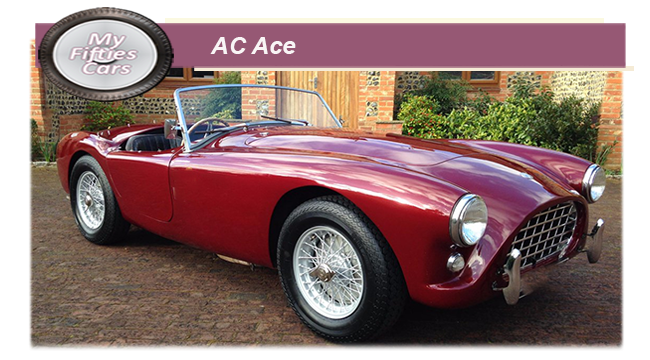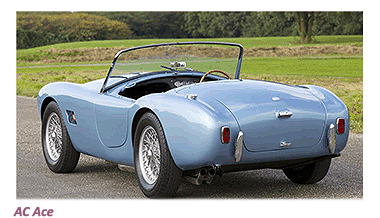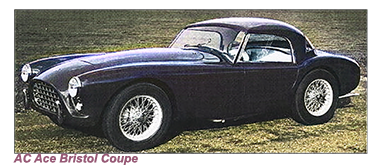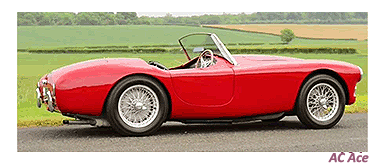 The driving force behind the design and development of the AC Ace was John Tojeiro, best known for his work developing high-performance cars, destined for the racetrack.
The driving force behind the design and development of the AC Ace was John Tojeiro, best known for his work developing high-performance cars, destined for the racetrack.
 AC commissioning Tojeiro to design the Ace was indeed a brave move, a far cry from the company’s policy of producing robust but practical motor cars.
The Ace was among the first cars to figure in what was described as the “great second wave” of open-top two-seaters which began in the early Fifties.
The Ace found itself competing with some hallowed competition, among them the MGA, the Austin-Healey 100 and the Triumph TR2.
AC commissioning Tojeiro to design the Ace was indeed a brave move, a far cry from the company’s policy of producing robust but practical motor cars.
The Ace was among the first cars to figure in what was described as the “great second wave” of open-top two-seaters which began in the early Fifties.
The Ace found itself competing with some hallowed competition, among them the MGA, the Austin-Healey 100 and the Triumph TR2.
 The AC Ace roadster made its debut in 1953, initially fitted with a version of AC’s well tried and tested six-cylinder engine that had first come off the drawing board just after the end of the First World War and remained in production until 1963.
The AC Ace roadster made its debut in 1953, initially fitted with a version of AC’s well tried and tested six-cylinder engine that had first come off the drawing board just after the end of the First World War and remained in production until 1963.
 The Ace's light weight made for potent performance, although it didn’t take too long for the realisation to sink through that the car needed a more powerful engine.
From 1957, AC began to fit the Ace with a new 1971cc engine, developed by Bristol derived from the prewar BMW developed straight six.
The AC Ace-Bristol, as it became known, enjoyed considerable track success, including decent outings in the punishing Le Mans 24 race in 1957 and 1958.
The Ace's light weight made for potent performance, although it didn’t take too long for the realisation to sink through that the car needed a more powerful engine.
From 1957, AC began to fit the Ace with a new 1971cc engine, developed by Bristol derived from the prewar BMW developed straight six.
The AC Ace-Bristol, as it became known, enjoyed considerable track success, including decent outings in the punishing Le Mans 24 race in 1957 and 1958.
![]()
Even then the original in-house engine remained an option, although in 1961 when Bristol pulled out of engine production, AC began to fit the Ace with a Ford Zephyr engine.
This switch provided its fair share of headaches for the AC’s engineering team, involving them with a chassis modification and the need to redesign the model’s entire front end.

 The new engine did bring some stunning results, with sports car aficionados regarding the AC Ace 2.6 version as the best and most powerful ever, with a top speed of 125 mph (201 km/h).
The new engine did bring some stunning results, with sports car aficionados regarding the AC Ace 2.6 version as the best and most powerful ever, with a top speed of 125 mph (201 km/h).
 Despite that ability, only 37 versionS of the AC 2.6 were ever produced as the car began to be phased out, to be replaced by the AC Cobra.
Despite that ability, only 37 versionS of the AC 2.6 were ever produced as the car began to be phased out, to be replaced by the AC Cobra.
AC did take full advantage of 'Ace' theme’s success by producing two “ spin-offs” the Aceca closed coupe unveiled in 1954 and a four-seater version, the Greyhound, built on a stretched Ace chassis.
![]()
As the production run unfolded, the splendid AC Ace was handed a number of improvements, among them being fitted with overdrive from 1956, front-wheel disc brakes from 1957, and 15in wheels from 1959.
 By that time the Ace was proving to be a top seller, despite strong competition and its heavy price tage.
By that time the Ace was proving to be a top seller, despite strong competition and its heavy price tage.
 Other variations on the 'Ace' theme included the Aceca closed coupe unveiled in 1954 and a four-seat Greyhound built on a stretched Ace chassis.
Other variations on the 'Ace' theme included the Aceca closed coupe unveiled in 1954 and a four-seat Greyhound built on a stretched Ace chassis.
By 1961 when the Ace was being discontinued, the car had played a major part in AC having reinvented itself as a sports car manufacturer to be reckoned with.
Take me back to the home page


